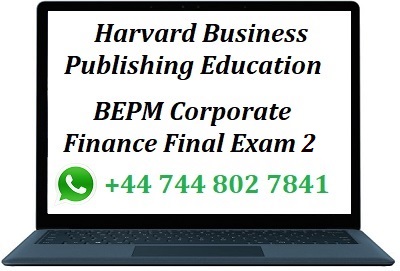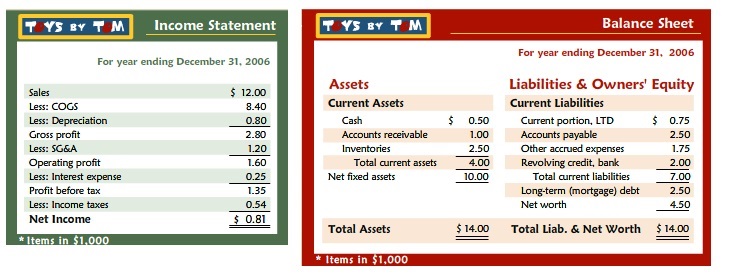Online Exam Help » Finance Assignment Help » Corporate Finance Assignment Help » Harvard Corporate Finance Final Exam 2
Harvard Corporate Finance Final Exam 2
 Q1. Which information is NOT required when calculating the weighted average cost of capital for a company with debt?
Q1. Which information is NOT required when calculating the weighted average cost of capital for a company with debt?
- Its capital structure ratios
- Its cost of debt
- Its current ratio
- Its tax rate
Q2. Common-size financial statements are constructed in order to:
- Adjust for inflation and risk
- Facilitate comparisons of different-sized companies
- To comply with SEC requirements
- All of the above
Q3. Which of the following liabilities form part of a company’s “real” activities?
I. Short-term debt
II. Accounts payable
III. Accrued operating expenses
IV. Long-term debt
- III only
- II and III
- I and IV
- I only
Q4. How is the cash conversion cycle calculated?
- Days in Inventory + Collection Period
- Days in Inventory – Payables Period
- Days in Inventory + Collection Period – Payables Period
- None of the above
Q5. Analysis of a company’s financial statements: Below are simplified versions of the balance sheet and income statement for Toys by Tom, Inc. Use this information to answer the following question.
What is Toys by Tom, Inc. return on assets (ROA)?
- 6.9%
- 0.86
- 18%
- 1.2

Q6. The Pecking Order Theory of capital structure implies a unique optimum capital structure.
- True
- False
Q7. For a levered firm, EBIT is equivalent to:
- Net income
- Pro forma earnings
- Operating profit
- Net income before taxes
Q8. A company can shorten its cash cycle by:
- Reducing inventory turnover
- Reducing account payables
- Reducing days receivable
- None of the above
Q9. The owner of Grandma’s Applesauce is planning to retire after the coming year. She has to repay a loan $50,000 plus 8 percent interest and must rely on cash flow from operations to do so. Cash flow from operations is uncertain; there is a 70% probability it will equal $65,000, and a 30% probability it will equal $45,000. Assuming a tax rate of 0%, what is the owner’s expected cash flow after debt service?
- $9,000
- $5,000
- $11,000
- $7,700
Q10. As EBIT drops, the return on equity (ROE) of a levered firm drops ______ the ROE of an otherwise identical unlevered firm.
- the same as
- relatively more than
- relatively less than
- more or less than (it cannot be determined)
Q11. Which of the following ratios uses sales in the denominator?
- Days in inventory
- Receivables turnover
- Cash ratio
- Average collection period
Q12. Which of the following is commonly used in preparing pro forma statements?
- Historical financial statements
- Projected sales
- Efficiency ratios
- All of the above
Q13. The sustainable growth rate is the maximum growth rate achievable over an extended period of time.
- True
- False
Q14. The cost of debt is generally lower than the cost of equity.
- True
- False
Q15. It is possible for a company to grow faster than its sustainable growth rate.
- True
- False
Q16. A higher level of leverage generally reduces managerial discretion.
- True
- False
Q17. Leverage and liquidity generally rise or fall together.
- True
- False
Q18. What is the present value of a perpetuity of $100 given a discount rate of 5%?
- $2,000
- $3,000
- $1,500
- $500
Q19. In general, the reduction of an asset is a source of funds.
- True
- False
Q20. Analysis of a company’s financial statements: Below are simplified versions of the balance sheet and income statement for Toys by Tom, Inc. Use this information to answer the following question.
Toys by Tom, Inc. has a current ratio of ____, suggesting ________.
- 9.6; reasonable ability to cover interest expense
- 0.57; potential illiquidity
- 0.21; potential collection problems
- 1.75; reasonable liquidity

Q21. An increase in financial leverage generally results in a higher return on equity (ROE).
- True
- False
Q22. Biases can and should always be eliminated in financial forecasts.
- True
- False
Q23. For a firm with an optimal capital structure, the weighted average cost of capital (WACC) is:
- higher than the cost of equity
- lower than the cost of debt
- lower than the cost of unlevered equity
- independent of the capital structure
Q24. For which of the following generic businesses would you expect a combination of high asset turnover and low profit margins?
- Supermarkets
- Banks
- Software developers
- Arlines
Q25. M&M’s Proposition I states that a company’s value is independent of its capital structure.
- True
- False
Q26. Operating cash flow is generated by a company’s daily operations related to production and sales of goods and/or services.
- True
- False
Q27. If you invest $2,000 today for three years at 5% interest paid annually, you will earn a total of $______ in interest. Assume you re-invest all interest.
- 205.00
- 300.00
- 315.25
- 500.00
Q28. Scenario analysis is a way of testing forecasts by changing one assumption at a time.
- True
- False
Q29. Which of the following is a example of indirect costs of bankruptcy?
- Court costs
- Attorney and advisor fees
- Lost sales due to customers and suppliers lost trust
- All of the above
Q30. Suppose a riskless project requires an initial investment of $10 and will generate a one-time cash inflow of $30 two years later. Assuming a risk-free interest rate of 5%, which of the following statements about the project is NOT true?
- The net present value of the project is positive.
- The IRR is greater than 50 percent.
- The accounting rate of return on the project is positive.
- The payback period is less than 2 years.
Q31. If you borrow capital to start a business and the money is provided interest-free, then your cost of capital is zero.
- True
- False
Q32. A company has a retention rate of 50%, sales of $25,000, beginning equity of $50,000 and profit margins of 10%, an asset turnover ratio of .75 and debt of $10,000. What is its sustainable growth rate?
- 2.5%
- 1.7%
- 3.75%
- Not enough information given
Q33. Which items are necessary in calculating the net present value of a project?
I. Investment outlays
II. Discount rate
III. Incremental cash flow
IV. Time period for the project
- I, II and IV
- I, II and III
- II, III and IV
- All of the above
Q34. Shareholders prefer high risk projects when facing a high probability of bankruptcy because
- high risk projects usually bring high rewards.
- shareholders have the residual claim on a company.
- creditors have the residual claim on a company, and therefore bear the risk.
- there is a good chance the government will rescue them in bankruptcy.
Q35. Which of the following assumptions regarding investor behavior are required by the CAPM?
I. Investors try to maximize their wealth
II. Investors consider only risk when making investments
III. Investors are risk averse
IV. Investors adopt a long-term perspective
- I and III
- I, II and III
- I and IV
- All of the above
Q36. The _________ states that the value of the firm is determined solely by the value of its assets.
- Static Tradeoff Model
- M&M proposition I
- The Pecking Order Model
- Agency Theory
Q37. What are pro forma statements?
- Summaries of historical financial statements
- Government-mandated analyses of financial statements
- Projected statements used in financial planning
- Estimated tax liabilities
Q38. All else equal, when a company’s debt ratio rises, its beta falls.
- True
- False
Q39. Which of the following is not an assumption underlying M&M proposition I?
- No arbitrage
- No taxes
- Corporate investments are risk-free
- Symmetric information
Q40. The NPV rule, which says companies should invest in projects for which NPV is greater than 0, depends on the assumption of value maximization.
- True
- False
Q41. A firm has $100 of average inventory, operating profit of $500 and sales of $1,500. What will be its days in inventory?
- 36.5 days
- 24.3 days
- 73.0 days
- Not enough information
Q42. The amount by which a project increases the value of the firm is given by the project’s ______.
- accounting rate of return
- net present value (NPV)
- internal rate of return (IRR)
- present value
Q43. Which trait is commonly found in debt contracts?
- Seniority
- Covenants
- Callability
- All of the above
Q44. Which of the following are equivalent under M&M proposition I?
- Maximizing firm value and maximizing firm profit
- Maximizing firm value and minimizing the cost of capital
- Minimizing firm’s cost of capital and minimizing firm’s debt burden
- Maximizing profit and minimizing taxes
Q45. Compute the net present value of an investment with 5 years of annual cash inflows of $100 and two cash outflows, one today of $100 and one at the beginning of the second year of $50. Use a discount rate of 10 percent.
- $229.08
- $287.60
- $233.62
- $271.53
Q46. In the CAPM, what does the parameter beta measure?
- Non-systematic (diversifiable) risk
- Systematic (non-diversifiable) risk
- Total risk
- Risk-adjusted stock returns
Q47. Selecting investment projects according to rules based either on project NPV or IRR results in maximizing firm value.
- True
- False
Q48. A dollar today is worth more than a dollar tomorrow.
- True
- False
Q49. Increasing a company’s leverage has no effect on its cost of equity.
- True
- False
Q50. Which of the following expresses the value of a levered firm (VL) in the Static Tradeoff model of optimal capital structure? [Note: VU denotes the value of the unlevered firm; CFD denotes expected costs of financial distress; and PV denotes present value.]
- VL = PV(Tax Shield) – PV(CFD)
- VL = VU + PV(Tax Shield) / PV(CFD)
- VL = VU + PV(Tax Shield) – PV(CFD)
- VL = VU + PV(Tax Shield)
Please click on Make Payment to get all correct answers at $60 (No Hidden Charges or any Sign Up Fee). In description, please don’t forget to mention the exam name – Harvard Corporate Finance Final Exam 2. You will receive the answers at your email id in the next 30 minutes.
